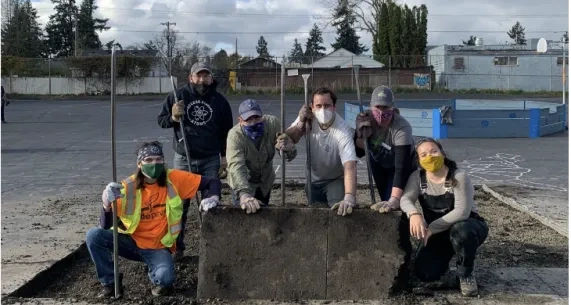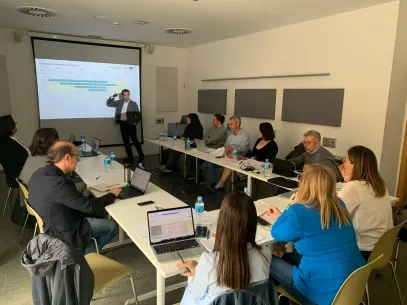Facing numerous challenges related to the COVID-19 pandemic, cities are testing and creating the future of local public action through multiple innovations in urban policy delivery. It is important to understand how these innovations will affect the way cities operate and how they will better prepare cities for the next crisis and increase their resilience.
Facing numerous challenges related to the COVID-19 pandemic, cities are testing and creating the future of local public action through multiple innovations in urban policy delivery. It is important to understand how these innovations will affect the way cities operate and how they will better prepare cities for the next crisis and increase their resilience. More concretely, this moment of change and possibility is also an opportunity for cities implementing innovative urban projects to learn from their peers about how to ensure more resilient governance under uncertain contexts.
To investigate these questions and make recommendations the UIA commissioned the present study which pursued the following goals:
- to understand the impacts that a global pandemic can have on the delivery of innovative projects at city-level.
- to analyse how urban authorities responded to those impacts and how they can improve their preparedness and responsiveness and be more resilient to any potential future large-scale crisis.
The key specific questions guiding this study were:
- What were the main challenges affecting the delivery of UIA projects?
- What were the responses and mitigation solutions implemented by UIA cities to overcome these challenges?
- What are the lessons for increasing preparedness and resilience in the future?
The study found three main themes where project delivery faced challenges and where the UIA projects surveyed found ways to adapt. These themes are Project & Partnership Management, Citizen & Stakeholder Participation, Public Procurement and Finance and this handbook is structured around them. What do they include?
The social distancing imposed by COVID-19 wreaked havoc for traditional working practices. With the transition to remote working and the spatial dispersion of co-workers, projects had to rapidly identify ways to become distributed and hybrid workplaces. This necessary adaptation mainly concerned three key dimensions of traditional office life: discussions in the workplace between colleagues; the way working documents are archived, shared, and edited by multiple contributors; and the way partners and co-workers could physically meet and carry-out field work. New uses of digital technologies revolutionised traditional workplaces, in particular by making online meetings effective, developing powerful online collaborative platforms and repositories and organising regular physical meetings and joint fieldwork.
Under the peculiar circumstances of the COVID-19 pandemic and the consequent spatial dispersion of co-workers working remotely, projects highlighted an increased need to clearly structure the organisation of work, the flow of communication, and progress monitoring by establishing working groups and specific communication protocols as well as by using project management and monitoring tools.
The continuous unexpected changes and thus the unprecedented uncertainty experienced during the pandemic, compromised projects’ initial implementation plans, methods, and timetables, and forced managers to improvise – with a high degree of flexibility – to quickly reorganise delivery methods, redefine priorities and project phases, and adjust project activities.
Confinement and social distancing allowed UIA projects to experiment with new and innovative approaches to citizen participation and stakeholder engagement. While confronting the pandemic’s dangers, they seized opportunities to innovate by moving their participative activities outside, exploring new forms of social gathering, downsizing groups, reaching out to different target groups, and inventing more open, agile, and creative approaches to participation.
UIA urban innovation projects have had to reinvent participation by taking advantage of the benefits of digital while avoiding its drawbacks. Online citizen participation and stakeholder engagement has gradually progressed from a simplistic transposition ‒ from one medium to another ‒ to a thoughtful project in making good use of available technologies, redesigning and supporting new digital participation including for the creation of online (digital) content.
The succession of periods of lockdowns and partial re-openings prompted cities to fine tune between face-to-face and distance participation, and gradually to validate a set of operational criteria for a hybrid mix of participation that is more suitable to citizen engagement and project-actor cooperation than either all-face-to-face or all-online options. The overall digital push brought positive outcomes, such as more flexibility or wider outreach but also negative ones, such as lower quality of participation, less engagement in the long run, but weaker connections with disadvantaged communities.
The unprecedented conditions imposed by the crisis forced a radical change in the practices of actors involved in innovative projects. The UIA projects have sought to identify which of these new participation practices constitute an improvement and make them standard practice in their cities. More generally, they have sought to adopt forms of digital participation and new practices with a view to using the most efficient mix between online and offline.
Without notice, the COVID-19 crisis forced changes in roles and responsibilities in city administrations. Project managers had to frequently check that those responsible for approving procurement initiatives were still in post and that they were continuing to fulfil this role.
To overcome project delays caused by procurement challenges, teams had to come up with solutions, which they did by looking for in-house providers, focusing on the required solution rather than the product/service to be procured, and by looking innovatively at local providers.
Projects reviewed their procurement requirements and prepared contingency proposals for modifying procurement processes to make the procuring of goods and services easier, including allowing more time for online procurement meetings with providers, and reviewing standard terms and conditions.
COVID-19 had a direct impact on project finances for many projects. Rising prices meant that budgets, set 1-2 years earlier, were inadequate, which made the work programmes they were supporting obsolete. Partners had to be pragmatic and seek more funding from their sponsors/cities, and/or reduce the scope of or change what was being purchased.
To overcome suppliers’ cash-flow challenges, projects offered more frequent invoice schedules to ensure that firms could continue to deliver their products or services. Project partners also struggled to maintain engagement and project momentum due to financial pressures. Lead Partners introduced more regular financial control meetings to have early warning of potential problems and have maintained this frequency since the pandemic.
About this resource
The Urban Innovative Actions (UIA) is a European Union initiative that provided funding to urban areas across Europe to test new and unproven solutions to urban challenges. The initiative had a total ERDF budget of €372 million for 2014-2020.
Similar content




